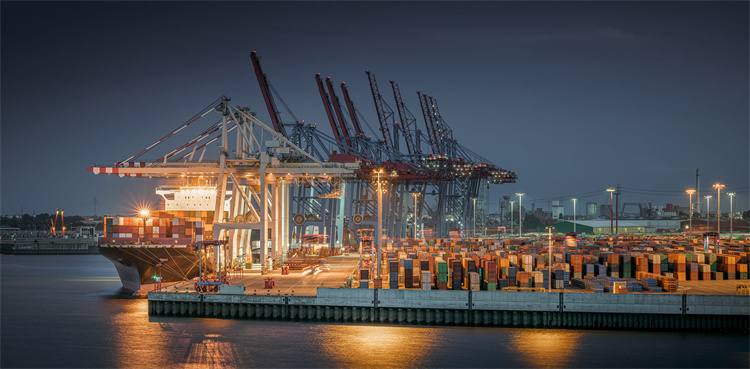How the Federal Reserve's Rate Cuts Promote Financing and Expansion in the Logistics Industry

The Federal Reserve's Rate Cuts play a crucial role in shaping economic dynamics. Lower interest rates make borrowing cheaper, encouraging businesses to invest and expand. This financial environment fosters economic growth by increasing consumer spending and capital expenditures. The logistics industry, a vital component of global trade, benefits significantly from these rate cuts. Reduced borrowing costs enable logistics companies to enhance their services and infrastructure. This expansion supports the efficient movement of goods worldwide, contributing to overall economic prosperity.
Understanding the Federal Reserve's Rate Cuts
Mechanisms of Rate Cuts
How Rate Cuts Work
The Federal Reserve's Rate Cuts influence borrowing costs. Lower rates make loans more affordable for businesses and consumers. Banks reduce interest rates on loans and mortgages. This encourages spending and investment. The economy receives a boost as money flows more freely.
Historical Context and Precedents
The Federal Reserve has a history of adjusting rates during economic challenges. In 2008, the Fed slashed rates to zero to combat the global financial crisis. This move aimed to stabilize the U.S. economy. In 2019, rate cuts addressed the U.S.-Chinese trade conflict. These actions had positive effects on economic growth. The Fed also implemented quantitative easing by buying bonds to stimulate the economy.
Objectives of Rate Cuts
Stimulating Economic Growth
The Federal Reserve's Rate Cuts aim to stimulate economic growth. Lower rates increase consumer spending. Businesses invest in new projects and technologies. The logistics industry benefits from these investments. Companies expand services and infrastructure. This growth supports efficient global trade.
Controlling Inflation
Controlling inflation remains a key objective. The Fed adjusts rates to maintain stable prices. Lower rates can prevent deflation during economic downturns. The Fed carefully monitors inflation indicators. Rate adjustments ensure balanced economic conditions.
Federal Reserve's Rate Cuts and Financing in the Logistics Industry

Access to Cheaper Credit
Lower Borrowing Costs
Federal Reserve's Rate Cuts reduce borrowing costs for logistics companies. Lower interest rates make loans more affordable. Businesses can secure financing with ease. This financial relief allows companies to allocate resources efficiently. Cost savings enhance competitiveness in the global market.
Increased Investment Opportunities
Logistics firms gain increased investment opportunities through Federal Reserve's Rate Cuts. Companies can invest in new projects and technologies. Access to capital encourages expansion and innovation. Businesses can explore strategic partnerships and collaborations. These investments drive growth and diversification.
Encouragement of Capital Expenditure
Infrastructure Development
Federal Reserve's Rate Cuts promote infrastructure development in the logistics sector. Companies can upgrade facilities and expand networks. Improved infrastructure supports efficient operations. Businesses can optimize logistics processes and reduce costs. Strategic alliances enhance service offerings and market reach.
Technology Upgrades
Technology upgrades become feasible with Federal Reserve's Rate Cuts. Logistics companies can implement advanced systems and tools. Big data and IoT applications improve decision-making. Cloud platforms enhance collaboration and resource utilization. These upgrades foster operational excellence and customer satisfaction.
Case Study: Contract Optimization Process
Implemented contract optimization led to a 15% reduction in shipping costs.
Reduced service provider usage and formed strategic alliances.
Achieved annual savings of $3,500,000.
Federal Reserve's Rate Cuts empower logistics businesses to achieve similar cost efficiencies. Companies can focus on optimizing operations and maximizing resources. The logistics industry benefits from enhanced capabilities and competitive advantages.
Expansion Opportunities in the Logistics Sector

Market Growth and Diversification
Entry into New Markets
Federal Reserve's Rate Cuts open doors for logistics companies to enter new markets. Lower borrowing costs allow businesses to expand operations. Companies can explore international markets with reduced financial risk. The logistics industry sees increased demand for freight services. Businesses invest in transportation and infrastructure to meet this demand. Rate cuts make it easier for logistics firms to compete globally. Companies can offer competitive pricing and services.
Expansion of Service Offerings
Logistics companies diversify service offerings due to Federal Reserve's Rate Cuts. Lower interest rates encourage investment in technology and innovation. Businesses introduce new services like multimodal transportation. Companies enhance supply chain efficiency with advanced systems. Rate cuts enable logistics firms to provide value-added services. Businesses focus on customer satisfaction and operational excellence. The logistics sector experiences growth through diverse service options.
Strategic Partnerships and Mergers
Collaborations with Tech Firms
Federal Reserve's Rate Cuts facilitate collaborations between logistics companies and tech firms. Lower borrowing costs support investments in technology partnerships. Logistics businesses integrate big data and IoT applications. Companies use cloud platforms to optimize supply chain management. Rate cuts drive innovation and technological advancements. Logistics firms enhance capabilities through strategic alliances. Businesses achieve operational efficiency and improved decision-making.
Mergers and Acquisitions
Mergers and acquisitions become viable strategies with Federal Reserve's Rate Cuts. Lower interest rates reduce the cost of financing deals. Logistics companies pursue mergers to expand market reach. Businesses acquire competitors to strengthen their position. Rate cuts create opportunities for consolidation in the logistics industry. Companies benefit from economies of scale and increased resources. The logistics sector witnesses growth through strategic mergers and acquisitions.
JUSDA's Role in Leveraging Rate Cuts
Integration of Advanced Technologies
Big Data and IoT Applications
JUSDA harnesses the power of big data and IoT applications to optimize logistics operations. Federal Reserve's Rate Cuts make it easier for JUSDA to invest in these technologies. Big data analytics provides valuable insights into supply chain dynamics. IoT devices enable real-time tracking of shipments. This technology integration enhances operational efficiency. Businesses benefit from improved decision-making and resource allocation.
Cloud Platform Utilization
Cloud platforms play a crucial role in JUSDA's logistics solutions. Federal Reserve's Rate Cuts facilitate investments in cloud technology. JUSDA uses cloud platforms to streamline collaboration among stakeholders. Suppliers, manufacturers, and service providers connect seamlessly. Cloud-based systems ensure efficient data management and communication. Businesses experience enhanced supply chain resilience and flexibility.
Global Expansion Strategies
Enhancing Service Routes
JUSDA focuses on enhancing service routes to expand its global reach. Federal Reserve's Rate Cuts provide the financial support needed for this expansion. JUSDA implements multimodal transportation strategies. Road, air, and rail transport options offer increased flexibility. Optimized routes reduce delivery times and costs. Businesses gain access to new markets with minimal financial risk.
Expanding Warehousing Capabilities
JUSDA invests in expanding warehousing capabilities to meet growing demand. Federal Reserve's Rate Cuts lower borrowing costs for infrastructure development. JUSDA operates over 2.5 million square meters of warehousing space. This expansion supports efficient distribution and storage solutions. Businesses benefit from scalable capacity and reduced transit times. JUSDA's warehousing capabilities ensure reliable logistics services.

JUSDA Solutions
To provide you with professional solutions and quotations.
Challenges and Considerations
Potential Risks of Over-leveraging
Debt Management Strategies
Federal Reserve's Rate Cuts provide logistics companies with easier access to credit. This access can lead to over-leveraging if not managed properly. Companies must develop effective debt management strategies. These strategies include setting clear financial goals and maintaining a balanced debt-to-equity ratio. Regular financial audits help monitor debt levels. Companies should also establish contingency plans for unexpected expenses. Proper debt management ensures long-term financial stability.
Economic Downturn Preparedness
Economic downturns pose significant risks to logistics companies. Federal Reserve's Rate Cuts may not always shield businesses from economic challenges. Companies need to prepare for potential downturns by building financial reserves. Diversifying revenue streams reduces dependency on a single market. Investing in technology enhances operational efficiency. This investment helps companies remain competitive during challenging times. Strategic planning and risk assessment are crucial for economic resilience.
Regulatory and Compliance Issues
Navigating Financial Regulations
Logistics companies must navigate complex financial regulations. Federal Reserve's Rate Cuts impact borrowing costs, but compliance remains essential. Companies should stay informed about changes in financial regulations. Regulatory bodies often update guidelines to ensure fair practices. Logistics professionals play a vital role in shaping legislation. Their input helps create regulations that support industry growth. Adhering to financial regulations builds trust with stakeholders.
Ensuring Sustainable Growth
Sustainable growth requires careful planning and execution. Federal Reserve's Rate Cuts encourage expansion, but sustainability is key. Companies should focus on environmentally friendly practices. Reducing carbon emissions aligns with global environmental standards. Implementing energy-efficient technologies lowers operational costs. Logistics firms should also consider social responsibility initiatives. These initiatives enhance brand reputation and customer loyalty. Sustainable growth ensures long-term success in the logistics industry.
Future Outlook
Long-term Effects of Rate Cuts
Predictions for the Logistics Industry
Federal Reserve's Rate Cuts will continue to shape the logistics industry. Lower borrowing costs will enable companies to expand operations. Businesses will invest in infrastructure and technology. The logistics sector will see growth in last-mile deliveries. Automation will become a key trend. Companies will focus on efficiency and customer satisfaction.
Economic Indicators to Watch
Key economic indicators will influence the logistics industry. Interest rates will affect borrowing costs. Inflation rates will impact consumer spending. Employment levels will determine demand for logistics services. Businesses must monitor these indicators closely. Strategic planning will ensure resilience in changing conditions.
Role of Innovation and Technology
Automation and AI in Logistics
Automation and AI will transform logistics operations. Federal Reserve's Rate Cuts will facilitate investments in these technologies. Companies will implement automated systems for efficiency. AI will enhance decision-making and resource allocation. Businesses will benefit from reduced costs and improved service quality.
Future Trends and Developments
Future trends will include intermodal rail services. These services offer environmentally friendly solutions. Federal Reserve's Rate Cuts will support investments in 3PL logistics. Companies will explore new markets and service offerings. Innovation will drive growth and competitiveness in the global market.
The Federal Reserve's rate cuts have a profound influence on the logistics industry. Lower borrowing costs enable logistics companies to expand operations and invest in new technologies. Increased consumer spending and business investment drive demand for freight services. Multi-modal transportation systems enhance supply chain efficiency, leading to higher profitability. Industry stakeholders express cautious optimism about improved freight market conditions. The future of logistics appears promising with continued economic activity and technological advancements.
See Also
Unlocking Logistics Savings: Confidential Tips for Efficient Supply Chains
Transforming Logistics: The Influence of Supply Chain Advancement
The Financials of Optimizing Supply Chain Expenses
JUSDA's Logistics Streamlining: Redefining Efficiency
Sustainable Efficiency: Revealing JUSDA's Logistics Expansion
